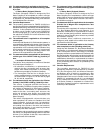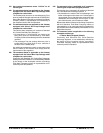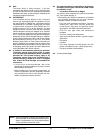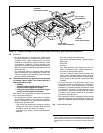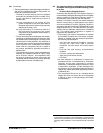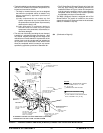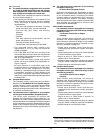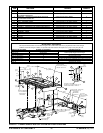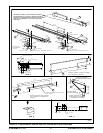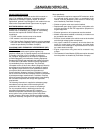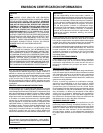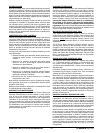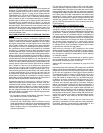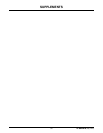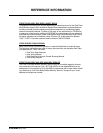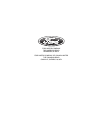
E-SERIES (May, 2004)50
E-SERIES (May, 2004) 51
CALIFORNIA FUEL VAPOR RECOVERY
California regulations require that the vehicle fuel systems be
designed to accommodate a vapor recovery fueling nozzle
including unobstructed access to the fill pipe. Fuel filler
pipes installed per Figure I on page 44 will comply with the
“Specications For Fill Pipes and Openings of Motor Vehicle
Fuel Tanks” referenced in Title 13 California Administrative
Code provided no part of the aftermarket body, as installed,
intrudes within a 254mm [10 in] radius cylinder which has its
axis parallel to the ground at point “Z” (Figure I on page 44
illustrates a typical point Z). The cylindrical zone uses the axis
described above, starts at the outer most surface of the Ford
supplied fuel ller housing, and projects outward (away from
the frame). The fuel pipe housing component is shown on the
referenced gures and is attached to the aftermarket body via
3/16 inch diameter rivets.
CALIFORNIA MOTOR VEHICLE EMISSION CONTROL
LABEL
To meet California emission certification regulations, the
Emission Control Information (tune-up) label must be welded,
riveted, or otherwise permanently attached to an area within
the engine compartment or to the engine in such a way that it
will be readily visible to the average person after installation
of the engine in a vehicle. In selecting an acceptable location,
the manufacturer shall consider the possibility of accidental
damage (e.g., possibility of tools or sharp instruments coming
in contact with the label). The label shall be afxed in such a
manner that it cannot be removed without being destroyed or
defaced, and shall not be afxed to any part which is likely to
be replaced during the vehicle’s useful life. For motor vehicles
rated at 6350 kg [14,000 lb] GVWR or less, the label shall not
be afxed to any equipment which is easily detached from the
vehicle. As used in these specications, readily visible to the
average person shall mean that the label shall be readable
from a distance of 460 mm [18 in] without any obstructions
from vehicle or engine parts (including all manufacturer
available optional equipment), except for exible parts, (e.g.,
vacuum hoses, ignition wires). Alternately, information required
by these specications to be printed on the label shall be
no smaller than 8 point type size provided that no vehicle or
engine parts (including all manufacturer available optional
equipment), except for exible parts that can be moved out of
the way without disconnection, obstruct the label.
Completed vehicles for retail sale in California require a
machine-readable Vehicle Identication Number (VIN) bar-
code label made of paper, plastic, metal, or other permanent
material which shall be afxed in a readily visible location to
either the door-latch post next to the driver’s seating position,
the door edge that meets this door-latch post, or above the
instrument panel in a location clearly visible through the lower
left corner of the windshield.
• All incomplete vehicles except Basic (Stripped) Chassis
type vehicles will conform to this standard.
• Basic (Stripped) Chassis type vehicles:
Conformity with CARB Motor Vehicle Emission Control
Label specications for VIN label is not substantially affected
by the design of this incomplete vehicle. Accordingly, Ford
Motor Company makes no representation as to conformity
with this requirement.
For the Vehicle Emission Control (VEC) and VIN labels,
sufcient clearance shall be provided to use a non-contact bar-
code Reading Wand. For the tune-up label and vacuum hose
routing diagram label, the label and any adhesives used shall
be designed to withstand typical vehicle environment conditions
in the area where the label is attached for the vehicle’s total
expected life. Typical vehicle environmental conditions shall
include, but are not limited to, exposure to engine lubricants and
coolants (e.g., gasoline, motor oil, brake uids, water, ethylene
glycol), under hood temperatures, steam cleaning, and paints
or paint solvents.
RADIO FREQUENCY INTERFERENCE (RFI)
The ignition system on your vehicle (if other than a Basic
(Stripped) Chassis) has been designed to be capable of
compliance with RFI requirements established by the Canadian
government. However, because Ford Motor Company has
no control over how an incomplete vehicle is completed by
subsequent stage manufacturers, Ford Motor Company does
not represent that the completed vehicle incorporating the
Ford-built components will comply with those requirements.
Any ignition system component (i.e.: spark plugs, ignition
wiring, coil suppressor assembly, etc.) that is replaced should
be replaced by the same Ford Motor Company part number
or equivalent to maintain RFI suppression.
While there are currently no RFI regulations in the United
States specically applicable to automotive ignition systems,
all Ford Motor Company trucks built with an ignition system
use the same or equivalent components to those supplied
on Canadian vehicles.
Ford Motor Company recommends that all ignition system
service be performed at a Ford authorized service facility to
help hold RFI emissions levels to a minimum.
Additional RFI information is contained on page 48 of this
manual.
Devices that emit radio frequency (RF) energy such as AM/FM
radios, mobile telecommunications systems (two-way radios,
telephones), and radio controlled security systems are subject
to the rules and regulations of the Federal Communications
Communication (FCC), including 47 CFR Parts 2 and 15. Any
such system installed in a vehicle should comply with those
rules and should be installed only by a qualied technician.
In addition, to ensure continued compliance with the FCC’s
regulations, RF devices must not be modied or changed in
a manner not expressly approved by Ford Motor Company
Mobile Communication Systems. RF devices particularly, if
not properly installed, may adversely affect the operation of
the vehicle. For example, such systems when operated may
cause the engine to stumble or stall. In addition, such systems
themselves may be damaged or their operation affected by
the operation of the vehicle. (Citizens Band [CB] transceivers,
garage door openers, and other transmitters whose power
output is 5 watts or less, ordinarily will NOT affect vehicle
operation.)
Because Ford Motor Company has no control over the
operation or manufacture of such systems or their installation,
Ford Motor Company cannot assume responsibility for any
adverse effects or damage if this equipment is used.
EMISSION CERTIFICATION INFORMATION



